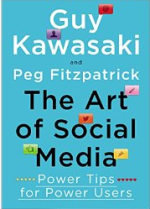If sharing is caring, Kawasaki and Fitzpatrick are the King and Queen of caring.
Hubspot’s Amanda Sibley hosted a webinar featuring Guy Kawasaki and Peg Fitzpatrick a/k/a The Dynamic Duo of Social Media. This was a no-nonsense webinar packed with useful information. Here are the Duo’s 10 Tips to Get More Followers:
- Be Valuable
– Inform, assist, and entertain your followers
– Pass the reshare test: create content people want to share with
their followers
– Embrace the NPR model: check their tweets out; you’ll want to be
just like them - Be Clever
– Piggyback onto existing services (Kawasaki’s Alltop.com, for example, where content is ready and waiting)
– Share what’s already popular – in a timely fashion
– Use lists, circles and communities – take advantage of existing groups - Be Gracious
– Show a little social love and share other people’s content
– Give thanks if someone shares your content or provides content you find valuable
– Stay positive or stay silent - Be Organized

– Use the right tool: Buffer, Sprout Social, Hootsuite
– Create a calendar
– Be consistent - Be Dramatic
– Add visuals
– Add text on top of visuals
– Add user-generated content - Be Optimal
– Perfect your profile – your face for profile pic; photo that tells story for cover photo
– Add share buttons: make it easy for your followers to spread your content
– Use optimal visual sizes for each social media forum: use largest photo
size possible to make your photo stand out - Be Bold
– Take a stand on an issue
– Express your personality
– Be topical and timely: jump into the conversation when it’s hot - Be Tough
– Embrace complaints
– Ignore trolls: you’ll come to recognize them soon enough
– Go three rounds: let the conversation go – three responses show that
you paid attention, and engaged your audience - Be Active
– Be calm and post often
– Repeat your tweets – Yes, repeat your tweets – 3x, every eight hours
– Get on Pinterest - Be Curious
– Experiment constantly
– Watch what others do
– Use incognito mode
Over-delivering on their promise of sharing their top 10 tips, Kawasaki and Fitzpatrick also let us in on a few power tips:
- You can add up to four pictures with each tweet; one picture will double your engagement.
- You can tag photos in your tweets and names tagged will not count as part of your 140 characters.
- Upload your video directly to Facebook rather than embedding a YouTube video on Facebook
- Promoting posts on Facebook is inexpensive and effective.
- In their continuing education, Kawasaki and Fitzpatrick are experimenting with paying to promote on Pinterest.
Put these tips in place, and I suspect your audience will grow and become more engaged. Keep me posted, and let me know about your success.







